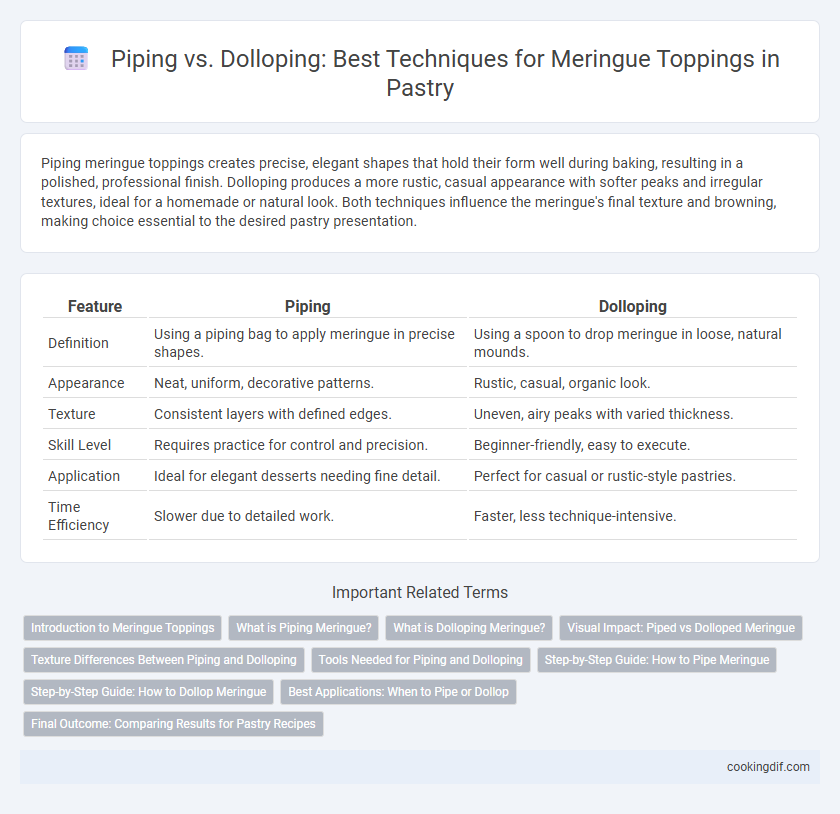Piping meringue toppings creates precise, elegant shapes that hold their form well during baking, resulting in a polished, professional finish. Dolloping produces a more rustic, casual appearance with softer peaks and irregular textures, ideal for a homemade or natural look. Both techniques influence the meringue's final texture and browning, making choice essential to the desired pastry presentation.
Table of Comparison
| Feature | Piping | Dolloping |
|---|---|---|
| Definition | Using a piping bag to apply meringue in precise shapes. | Using a spoon to drop meringue in loose, natural mounds. |
| Appearance | Neat, uniform, decorative patterns. | Rustic, casual, organic look. |
| Texture | Consistent layers with defined edges. | Uneven, airy peaks with varied thickness. |
| Skill Level | Requires practice for control and precision. | Beginner-friendly, easy to execute. |
| Application | Ideal for elegant desserts needing fine detail. | Perfect for casual or rustic-style pastries. |
| Time Efficiency | Slower due to detailed work. | Faster, less technique-intensive. |
Introduction to Meringue Toppings
Meringue toppings can be applied through piping or dolloping, each technique affecting texture and presentation significantly. Piping creates precise shapes with crisp edges ideal for decorative finishes, while dolloping produces a more rustic, airy appearance with soft peaks. The choice depends on the desired visual impact and mouthfeel, enhancing the overall pastry experience.
What is Piping Meringue?
Piping meringue involves using a pastry bag fitted with various nozzles to create precise, decorative shapes and patterns on desserts, enhancing both texture and visual appeal. This technique allows for consistent sizing and intricate designs, making it ideal for topping pavlovas, cupcakes, and tarts. Piped meringue crisps beautifully when baked, adding a delicate crunch and an elegant finish to pastry creations.
What is Dolloping Meringue?
Dolloping meringue involves spooning generous, uneven portions of the mixture onto desserts, creating a rustic and textured appearance. This technique enhances the visual appeal by forming soft peaks and natural curves, perfect for casual presentations like pavlovas or berry tarts. Unlike precise piping, dolloping emphasizes volume and organic shapes, providing a charming, homemade aesthetic while maintaining the meringue's light and airy texture.
Visual Impact: Piped vs Dolloped Meringue
Piped meringue toppings create precise, uniform peaks that enhance visual appeal with intricate patterns and a professional finish, ideal for elegant desserts. Dolloped meringue offers a rustic, organic look with soft, irregular shapes that convey a homemade charm and texture variation. Choosing between piping and dolloping meringue influences the dessert's presentation and perceived sophistication, aligning with the desired aesthetic impact.
Texture Differences Between Piping and Dolloping
Piping meringue creates smooth, uniform peaks with a crisp outer shell and a tender, airy interior, enhancing the overall texture and visual appeal of desserts. Dolloping meringue results in a more rustic, uneven surface with soft, fluffy pockets that offer a creamy mouthfeel. The choice between piping and dolloping directly influences the final texture, affecting both the crispness and softness of the meringue topping.
Tools Needed for Piping and Dolloping
Piping meringue toppings requires a piping bag fitted with various nozzles or tips, such as star or round tips, to create precise and decorative shapes. Dolloping meringue involves using a spoon or spatula to manually place generous scoops onto the pastry, resulting in a rustic, textured finish. Each method demands different tools: piping emphasizes control and detailing tools, while dolloping relies on simple utensils for a more casual presentation.
Step-by-Step Guide: How to Pipe Meringue
To pipe meringue toppings, begin by transferring the whipped meringue into a piping bag fitted with your desired nozzle, such as a star or round tip. Hold the bag vertically above the dessert surface, applying consistent pressure to create smooth, controlled shapes and spirals while lifting the bag gradually to form peaks. Finish each piped design by gently twisting the tip to secure the shape, ensuring uniformity and an elegant presentation.
Step-by-Step Guide: How to Dollop Meringue
To dollop meringue toppings, use a large spoon or ice cream scoop to scoop generous portions onto the pastry surface, creating soft, rounded peaks. Gently release each dollop onto the dessert without spreading, preserving the airy texture and rustic appearance. This technique enhances volume and maintains lightness, ideal for pavlovas and lemon meringue pies.
Best Applications: When to Pipe or Dollop
Piping meringue toppings is ideal for creating elegant, uniform shapes such as rosettes or peaks, perfect for decorating cupcakes and pavlovas. Dolloping works best for rustic, casual presentations like on pies or tarts, where a natural, textured look is desired. Selecting piping or dolloping depends on the desired aesthetic and precision required for the pastry design.
Final Outcome: Comparing Results for Pastry Recipes
Piping meringue creates precise, uniform peaks with a crisp exterior and tender interior, enhancing the visual appeal and even baking throughout pastries like lemon meringue pies and pavlovas. Dolloping results in a more rustic, organic texture with varied thickness, leading to caramelized edges that add flavor complexity but less consistent baking. Choosing between piping and dolloping affects not only the aesthetic but also the texture and flavor balance in final pastry presentations.
Piping vs Dolloping for meringue toppings Infographic

 cookingdif.com
cookingdif.com